The gorgeously blue polar blue parrot cichlids result from artificial cross-breeding between two attractive cichlids. It is an unusual type of fish, so many aquarists want to own one.
They bring together the looks, power, and aggression of the convict cichlids and the parrot cichlids. Their breeding habits are not so different from their parents, and they are not hard to care for, similar to their cross-bred ancestors.
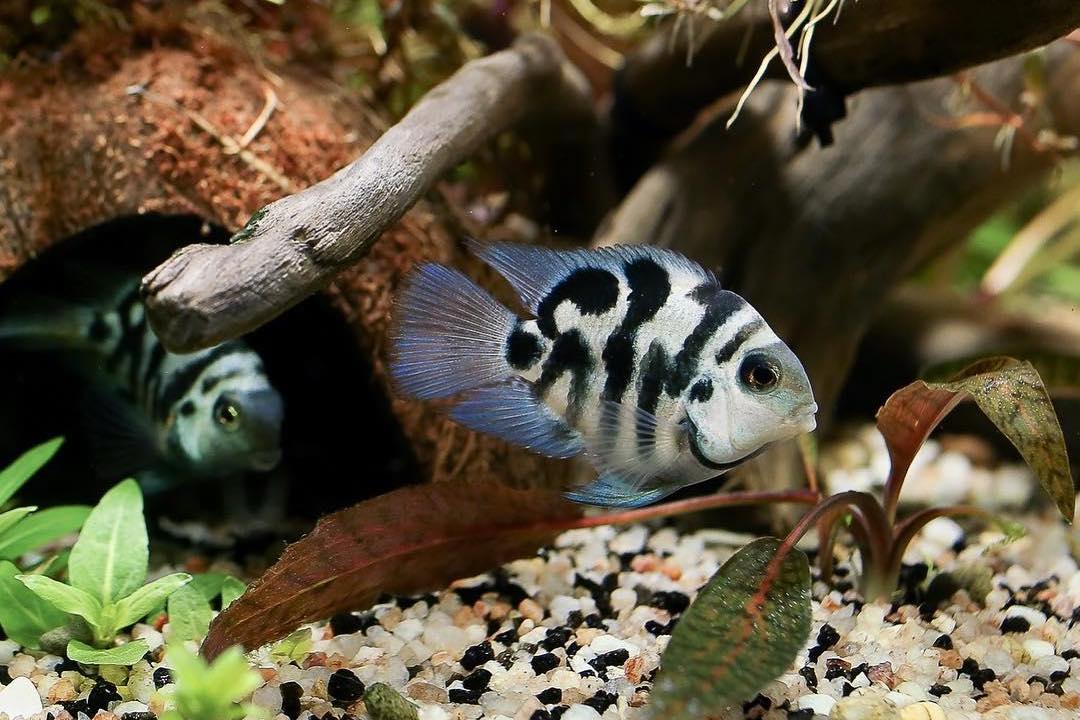
Read on to learn all the important facts about the polar blue parrot. Get to know their origin and physical characteristics.
All you need to know to carefully and successfully care for the beautiful species is outlined in detail below.
Polar Blue Parrot Cichlids Overview
Short Summary of Polar Blue Parrot Cichlids and their habitats:
| Names | Polar blue parrot cichlids
Also known as the polar blue convict parrot cichlid |
| Origins and Reginal Distribution | Cross-breed of male convicts and female parrot cichlids found in Western Atlantic regions, including Bermuda, Bahamas, Brazil, and the United States |
| Tank Size | 52 gallons Minimum for a community
75 gallons minimum for adults and breeding purposes |
| Water Hardness Conditions | 9 – 20 KH |
| Ideal Tank Mates | Less aggressive, equal sized fish. |
| Average Size | 3-4 inches, almost 5 inches in the ideal environment |
| Colors | Pale white base color with black stripes and a shiny blue spot. |
| Breeding | Egg-laying |
| Lifespan | Typically, 5 years, but can live up to 10 years in the ideal environment |
| Lighting Conditions | Low light for up to 12 hours |
| Diet | Omnivorous diet |
| Optimal pH levels | 6.5 – 8.0 |
| Optimal Temperature | 75 – 85 degrees Fahrenheit |
The pale blue hue of the polar blue parrot fish is because of the fact that this species was born from the cross-breed of male convict cichlids and female blood cichlids (also known as the parrot cichlids).
Parrot cichlids originate from Taiwan, China, and have been known since the late 1990s and the early 2000s. On the other hand, the polar blue parrot doesn’t have an exact date of origin, but hobbyists started buying them in plenty in the early 2000s.
Polar blues are loved for their one-of-a-kind color that is hard to mistake for another breed. They are also a good addition to your tank since they love playing amongst themselves.
You will often see them banding up in groups of three or more to swim around and play with each other.
The fish get their name from how their bodies look. This is the animal you might picture if you were told to imagine a gorgeous convict cichlid color and pair it up with the body shape of a parrot.
Lifespan
The polar blue parrot is a hardy creature that will live for years, even in less ideal conditions. The life expectancy is, on average, between 5 to 8 years.
However, in the best climate, natural habitat, or ideal aquarium tank conditions, the polar blue parrot can live up to 10 years.
Its long life is attributed to the fact that it is a hybrid of two species that live for more than five years, even in less ideal conditions.
Appearance: Size & Colors
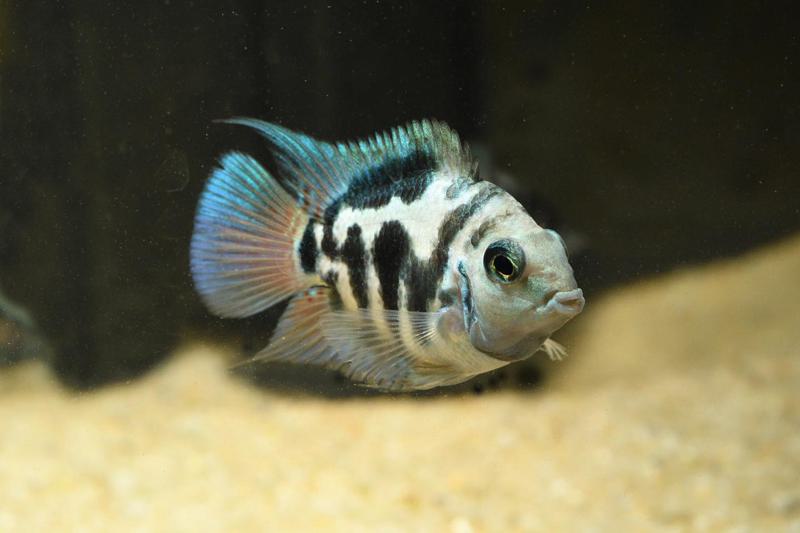
So, how big do blue parrot fish get? A full grown polar blue parrot cichlid is about 3 – 4 inches long, but you can expect them to get up to 5 inches tall in ideal conditions and stable water parameters.
Many hobbyists confuse the polar blue parrot’s size with the common blood parrot’s size. The blood parrot is long, stretching up to 8 inches and maybe 10 inches in rare cases.
The polar cichlid wasn’t fortunate enough to inherit this trait from the blood parrot. Instead, it inherited its average size from the male convict cichlids, which have an average height of about 4 to 6 inches.
The polar blue parrot cichlid growth rate is faster than most common aquarium fish. You can expect a young juvenile to reach up to 3 inches in under five months.
Its appearance is distinct from any other fish in the sea. Polar blue parrots come with a compact shape and size that does not allow the digestion of a lot of foods, just small bites in small portions.
The compact size features a round body and a mouth that protrudes like a blood parrot’s mouth. It borrows its colors from the convict cichlids, which feature light base colors with dark stripes.
White is the base color in this case, evenly spread out with dark black stripes from head to toe. The name blue in their name comes from a shiny blue spot on their body that looks like a patch of blue glitter.
Please keep in mind that the polar blue parrots are not polymorphic. This means that they will not come in multiple color variants. It is also important to note that the cichlids do not lose their color arrays; they maintain them throughout their lives.
The cichlid is infected or injured if you see any weird color changes.
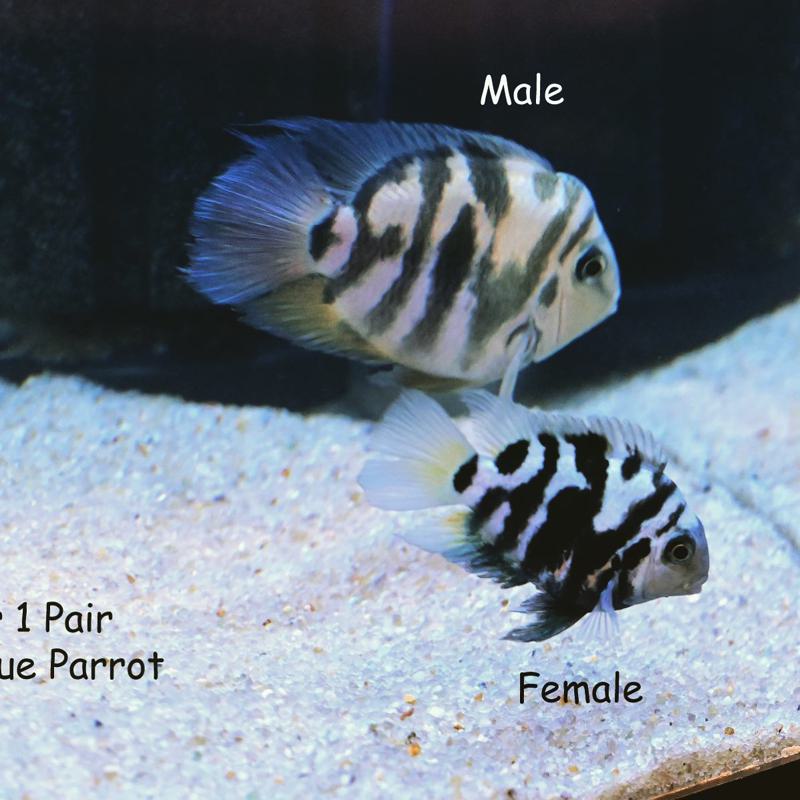
Another physical appearance aspect is differentiating the male polar blue parrot cichlids from the female ones.
Differentiating the two is practically impossible when they are juveniles and just a few months old. As they reach maturity and are ready for breeding, it becomes much easier to tell the sexes apart.
Unlike other cichlid species, the male polar parrot cichlids are thinner than their female counterparts. The males make up for it with wider rounded bodies and longer sizes. The females are thicker than the males but typically shorter in length.
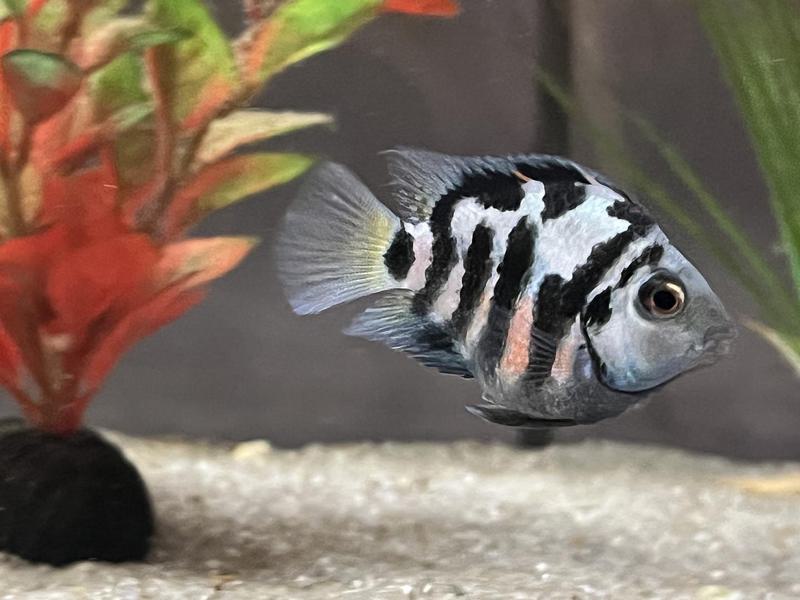
Breeding season is the best time to tell the male from the female. Females develop a larger stomach when they start carrying eggs. This causes discoloration on the lower side of the stomach, creating a spot that looks orange or yellow.
Adult polar blue parrot cichlids include males with red rail fins and females with blue-like tail fins.
However, it is not advisable to use colors to tell the species apart. This is because of the common misnaming that occurs when you cross breed many species.
Behaviors
So, are polar blue cichlids aggressive? The polar parrot cichlid’s aggression only comes out when they feel threatened, bullied, or stressed.
Otherwise, the polar parrots are relatively peaceful; you will often find them getting along with their compatible tank mates, especially if you put them in a polar parrot cichlid-only tank.
The aggression is also often directed towards smaller fish than bigger fish. This means that if you have bigger fish that can bully and eat the polar blue parrots, then rest assured that the smaller parrots will soon turn into snacks.
Like other aggressive fish, they will swim about quickly, knocking over any loose objects, from rocks to decorations and equipment.
Ensure you have enough hiding spots in your aquarium to help them adapt quicker before they get stressed.
Polar Blue Parrot Cichlid Care
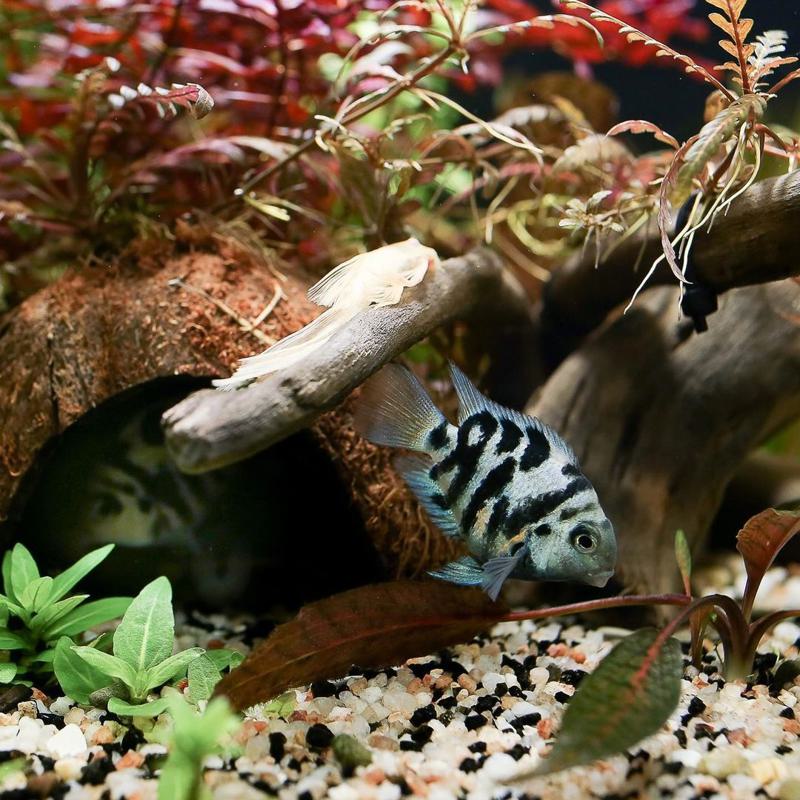
Polar parrot cichlids are easy to care for. They are hardy fish that require little maintenance and will populate your tank for years to come without much effort on your part.
The main things to keep in mind are the tank mates and the daily feeding cycle.
Tank Size & Environment
A 30-gallon tank for one pair of polar blue parrots is sufficient to get you started. A 50-gallon tank is more practical and leaves room for growth and adventure.
As your stock grows and you add more animals or décor into the tank, you will have to consider upgrading the system to a 75-gallon tank which will provide more space and reduce aggression between the tank mates.
A parrot cichlid can live with lots of other fish, but it will thrive more in a tank that has its own kind. Their aggression can make them eat smaller fish.
This is ironic since the polar parrots are smaller than the Oscars and will often be the bigger fish’s meal if they get the chance.

It would be best if you avoid keeping the polar parrots with smaller fish like Guppies or Platies.
The best tank mates for the polar blue parrot cichlids include:
- Angelfish
- Various types of Central American cichlids
- Severum cichlids
- Parrot cichlids
- Cory catfish
- Plecos
Polar blue parrots thrive in pairs and with a community of more than five cichlids. This helps reduce stress and also, the aggression.
You also don’t want a lot of competition during breeding because the cichlids get more aggressive when mating and protecting their young ones.
A soft substrate is ideal for polar blue parrots. Rocky and hard surfaces can hinder their movement but serve as great places for laying eggs.
A rule of thumb is to have a sandier substrate to offer a huge smooth terrain but put a few decors and rocks here and there for when the breeding season comes.
You do not have to worry about simulating their natural environment with decor. However, it is advisable to use plant pots since the fish can uproot the plants as they aggressively move about.
Cichlids can thrive in many lighting conditions in the tank, but it is advisable to keep the lighting low. Keep the lights low for up to 12 hours and allow the fish to rest at night in darkness.
These are not nocturnal fish, so you should not leave the lights on at night. A good formula for optimum lighting is 0.5 Watts per Gallon.
Water Quality & Water Parameters
Polar blue parrots can survive in many conditions, but it is always best to keep the water parameters at their ideal natural levels.
Poor water quality is the leading cause of death in fish, and this can be easily prevented in the cichlids by keeping these conditions stable:
- Water Temperature: 75 – 85 degrees Fahrenheit
- pH level: 5 – 8.0
- Water hardness: 9 – 20 KH
- Ammonia, nitrite levels: 0 PPM
Polar Blue Parrot Cichlid Diet
Polar cichlids are omnivores. They thrive on a high protein diet which is the opposite of their sister cichlids like the red zebra cichlid.
Their body shape and size do not allow the cichlids to have heavy meals. To feed them properly, ensure you keep their meals small, sliced, and tiny. Feed them about two to three times per day, and they will be golden.
Larger meals will go to waste, and this will increase the number of leftovers as well as biowaste. More food could also prompt these fast eaters to feed more, but this is dangerous as it can lead to bloating complications in the fish.
Some of the best foods for polar blue parrots include:
- Brine shrimp
- Hikari pallets
- Frozen bloodworms
- Frozen krill
- Crickets
- Brie shrimp
- Earthworms
- Vegetables like peas, spinach, cucumber, broccoli, lettuce, and zucchini
- Cichlid flakes
Breeding
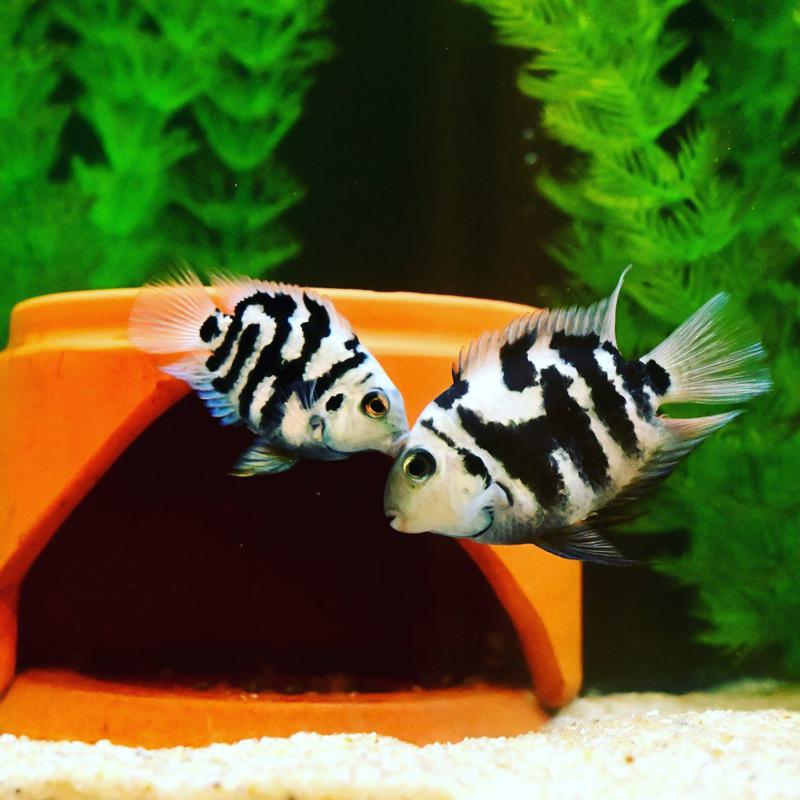
Polar blue parrots are oviparous. This means that the female lays eggs on the substrate, and the male fertilizes them afterward. As maternal fish, the cichlids are very defensive of their young ones, which is their most aggressive stage.
The male and the female cichlids protect their babies before and after hatching. The father guards the eggs and can bite anyone, including their own kin, during this stage.
When starting the breeding season, it is best you increase the temperatures. You may also want to separate the fish into a different tank if you have an inter-species community.
Once the female is ready, she will lay about 100 to 300 eggs on the surface, and the male will fertilize them soon after. The eggs hatch in about four to five days; the father stands by protecting his family throughout that period.
At this point, some aquarist will separate the hatched fry from their parents. This is because the parents tend to eat the fry babies, but it is not by nature. With that in mind, ensure you separate the younglings from the adult fish to give them a conducive environment to grow fully.
The growth rate of the polar blue parrot cichlid is average; you can expect the babies to grow up to 2 cm (0.79 inches) after one month since birth.
Best parameters for polar blue parrot cichlids to breed:
- Temperature: above 80 degrees Fahrenheit
- Diet: High Vegetable Diet, fewer proteins/meats diet (good foods include fry fish and fry groundfish flakes)
- Water pH levels: Above 7.8
- Water Hardness: 9 – 20 KH
Read More:
- Bolivian Ram Cichlid
- Yellow Lab Cichlid
- Red Zebra Cichlid
- Electric Blue Ram Cichlid
- Giraffe Cichlid (Venustus Cichlid)
- Jaguar Cichlid
Final Thoughts
If you are looking for polar blue parrot cichlids up for sale, then online pet stores are a great place to start. It is harder to find this species in your local store since they are not as common as other fish, like the parrot cichlids.
Regardless, local fish breeders will offer higher-quality stocks than what you can find online, but this also means the price will be higher.
You can spend between $15 to $25 for one single pair of juveniles of about 1-2 inches in size. Please remember that it is always best to pair the parrot cichlid with one or two of its kind.